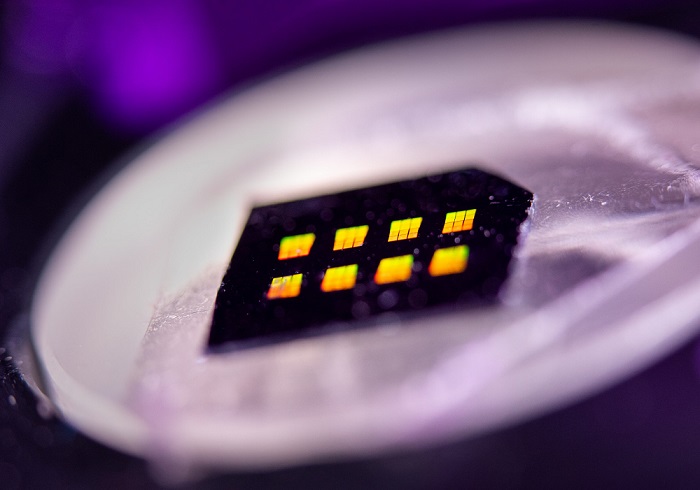A research team at Sandia National Laboratories has demonstrated a technique that dynamically steers light pulses from conventional incoherent light sources. The ability to control incoherent light with a semiconductor device could allow low-power, low-cost sources such as LEDs or flashlight bulbs to replace laser beams in technologies such as holograms, remote sensing, self-driving cars, and high-speed communication.
So-called incoherent light, which is emitted by sources such as incandescent light bulbs and LEDs, takes its name because the photons are emitted with different wavelengths and in a random fashion. A beam of light from a laser, so-called coherent light, does not spread and diffuse because the photons have the same frequency and phase.

As a red beam of light is reflected in an arch, Prasad Iyer (right) and Igal Brener demonstrate optical hardware used for beam-steering experiments at Sandia National Laboratories’ Center for Integrated Nanotechnologies. Courtesy of Craig Fritz.
The researchers manipulated incoherent light using metasurfaces made from tiny building blocks of semiconductors, called meta-atoms, that can be designed to reflect light efficiently. According to Sandia researcher Igal Brener, although there have been prior demonstrations of static metasurfaces that can emit incoherent light which could be steered to a particular angle, that angle was fixed by design. Ideally, one would want a semiconductor device that could emit light like an LED, steer the light emission to a set angle by applying a control voltage, and shift the steering angle at the fastest speed possible.
The researchers started with a gallium arsenide semiconductor metasurface embedded with indium arsenide quantum dot light sources. Using a control optical pulse, they changed, or reconfigured, the way that the surface reflected light and steered the lightwaves emitted from the quantum dots in different directions over a 70° range for less than one-trillionth of a second. Similar to laser-based steering, the steered beam restrained the tendency of incoherent light to spread over a wider viewing angle and instead produced bright light at a distance.
“For this concept to work, one has to create a large modulation of the refractive index in the shape of a periodic sawtooth profile superimposed on the metasurface,” Brener told Photonics Media. “There is no current technology that can provide this in a reconfigurable way. The optical control was our way to create this dynamic index modulation and served the purpose of demonstrating the proof of concept. In a final device that could be commercialized, you would want to do this with additional contacts/electrodes, so this would be a compact, electrically driven device.”

A metasurface sample is used for the beam-steering with each reflective patch containing thousands of meta-atoms designed to dynamically steer incoherent light. Courtesy of Craig Fritz.
The proof-of-principle work paves the way for developments in a range of nanophotonics and ultrafast optics applications.
One low-power use would be to brighten augmented reality military helmet screens.
“In applications where space is valuable, steering light emission with low-size-and-weight metasurface-LED displays could be made possible in the future with this technology,” said Prasad Iyer, Sandia scientist and lead author of the research paper. “We can use the light emitted in a better way rather than just turning them off and on.”
The technique could also enable a new kind of small display that can project holographic images onto eyeballs using low-power LEDs, which is a capability of interest for augmented and virtual reality devices. Other uses could be in self-driving cars where lidar is used to sense objects in the vehicle’s path.
According to Brener, the team has had several inquiries from commercial sources. He said that a commercial product could be five to 10 years out, especially if the product was to support all functionality on a chip.
The research was published in Nature Photonics (www.doi.org/10.1038/s41566-023-01172-6).